Entrepreneurship and Small Business Management Report for U.K. Firms
VerifiedAdded on 2021/01/02
|16
|4547
|211
Report
AI Summary
This report delves into the realm of entrepreneurship, focusing on various venture types such as small businesses, scalable ventures, and social enterprises, and their relationships with entrepreneurial typologies. It examines the contributions of micro and small businesses to the UK economy, highlighting their role in employment and economic growth. The report explores the characteristics and traits of successful entrepreneurs, including aspects of entrepreneurial personality and how background can either foster or hinder entrepreneurial endeavors. It covers key areas like the similarities and differences between entrepreneurial ventures, and the impact of different ventures on the UK economy. The report uses resources from a UK-based recruitment firm as a case study to illustrate the concepts. Finally, it provides insights into the scope, development, and growth of entrepreneurship ventures.

Entrepreneurship and small
business management
business management
Paraphrase This Document
Need a fresh take? Get an instant paraphrase of this document with our AI Paraphraser

Table of Contents
INTRODUCTION...........................................................................................................................1
TASK1 ............................................................................................................................................1
P.1 Types of entrepreneurial ventures and their relationship with typologies ...........................1
Similarities and differences between entrepreneurial ventures ..................................................3
TASK 2............................................................................................................................................6
A) Contribution of small and micro business on economy of UK .............................................6
B) Role of small firm and their contribution ..............................................................................7
C) Importance of small business and start ups ...........................................................................8
TASK 3............................................................................................................................................9
P5 Traits and characteristic of successful entrepreneurs.............................................................9
P6 Aspects of entrepreneurial personality ................................................................................10
TASK 4..........................................................................................................................................11
P7 How background of entrepreneur can hinder entrepreneurship...........................................11
CONCLUSION ............................................................................................................................11
REFERENCES..............................................................................................................................12
.......................................................................................................................................................13
INTRODUCTION...........................................................................................................................1
TASK1 ............................................................................................................................................1
P.1 Types of entrepreneurial ventures and their relationship with typologies ...........................1
Similarities and differences between entrepreneurial ventures ..................................................3
TASK 2............................................................................................................................................6
A) Contribution of small and micro business on economy of UK .............................................6
B) Role of small firm and their contribution ..............................................................................7
C) Importance of small business and start ups ...........................................................................8
TASK 3............................................................................................................................................9
P5 Traits and characteristic of successful entrepreneurs.............................................................9
P6 Aspects of entrepreneurial personality ................................................................................10
TASK 4..........................................................................................................................................11
P7 How background of entrepreneur can hinder entrepreneurship...........................................11
CONCLUSION ............................................................................................................................11
REFERENCES..............................................................................................................................12
.......................................................................................................................................................13
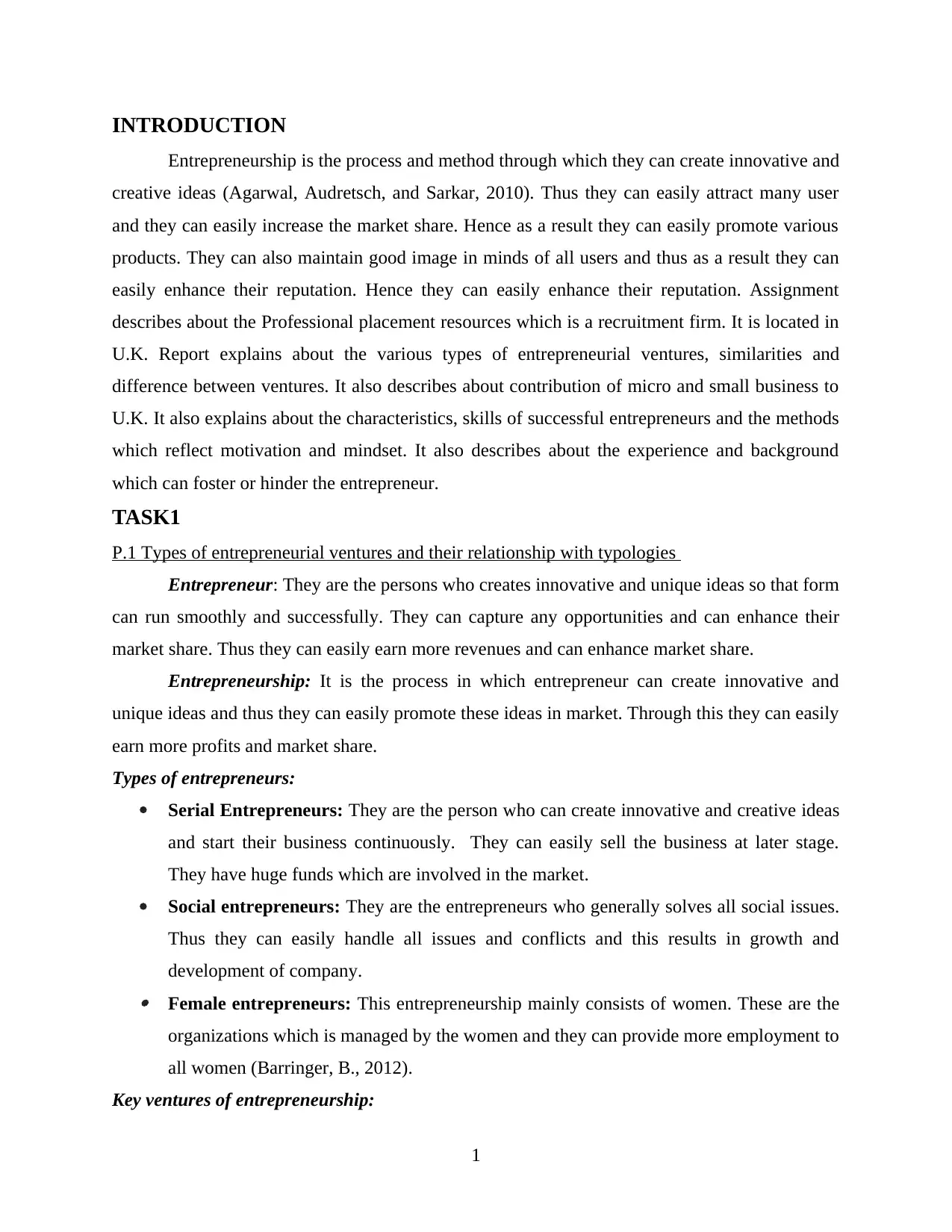
INTRODUCTION
Entrepreneurship is the process and method through which they can create innovative and
creative ideas (Agarwal, Audretsch, and Sarkar, 2010). Thus they can easily attract many user
and they can easily increase the market share. Hence as a result they can easily promote various
products. They can also maintain good image in minds of all users and thus as a result they can
easily enhance their reputation. Hence they can easily enhance their reputation. Assignment
describes about the Professional placement resources which is a recruitment firm. It is located in
U.K. Report explains about the various types of entrepreneurial ventures, similarities and
difference between ventures. It also describes about contribution of micro and small business to
U.K. It also explains about the characteristics, skills of successful entrepreneurs and the methods
which reflect motivation and mindset. It also describes about the experience and background
which can foster or hinder the entrepreneur.
TASK1
P.1 Types of entrepreneurial ventures and their relationship with typologies
Entrepreneur: They are the persons who creates innovative and unique ideas so that form
can run smoothly and successfully. They can capture any opportunities and can enhance their
market share. Thus they can easily earn more revenues and can enhance market share.
Entrepreneurship: It is the process in which entrepreneur can create innovative and
unique ideas and thus they can easily promote these ideas in market. Through this they can easily
earn more profits and market share.
Types of entrepreneurs:
Serial Entrepreneurs: They are the person who can create innovative and creative ideas
and start their business continuously. They can easily sell the business at later stage.
They have huge funds which are involved in the market.
Social entrepreneurs: They are the entrepreneurs who generally solves all social issues.
Thus they can easily handle all issues and conflicts and this results in growth and
development of company. Female entrepreneurs: This entrepreneurship mainly consists of women. These are the
organizations which is managed by the women and they can provide more employment to
all women (Barringer, B., 2012).
Key ventures of entrepreneurship:
1
Entrepreneurship is the process and method through which they can create innovative and
creative ideas (Agarwal, Audretsch, and Sarkar, 2010). Thus they can easily attract many user
and they can easily increase the market share. Hence as a result they can easily promote various
products. They can also maintain good image in minds of all users and thus as a result they can
easily enhance their reputation. Hence they can easily enhance their reputation. Assignment
describes about the Professional placement resources which is a recruitment firm. It is located in
U.K. Report explains about the various types of entrepreneurial ventures, similarities and
difference between ventures. It also describes about contribution of micro and small business to
U.K. It also explains about the characteristics, skills of successful entrepreneurs and the methods
which reflect motivation and mindset. It also describes about the experience and background
which can foster or hinder the entrepreneur.
TASK1
P.1 Types of entrepreneurial ventures and their relationship with typologies
Entrepreneur: They are the persons who creates innovative and unique ideas so that form
can run smoothly and successfully. They can capture any opportunities and can enhance their
market share. Thus they can easily earn more revenues and can enhance market share.
Entrepreneurship: It is the process in which entrepreneur can create innovative and
unique ideas and thus they can easily promote these ideas in market. Through this they can easily
earn more profits and market share.
Types of entrepreneurs:
Serial Entrepreneurs: They are the person who can create innovative and creative ideas
and start their business continuously. They can easily sell the business at later stage.
They have huge funds which are involved in the market.
Social entrepreneurs: They are the entrepreneurs who generally solves all social issues.
Thus they can easily handle all issues and conflicts and this results in growth and
development of company. Female entrepreneurs: This entrepreneurship mainly consists of women. These are the
organizations which is managed by the women and they can provide more employment to
all women (Barringer, B., 2012).
Key ventures of entrepreneurship:
1
⊘ This is a preview!⊘
Do you want full access?
Subscribe today to unlock all pages.

Trusted by 1+ million students worldwide
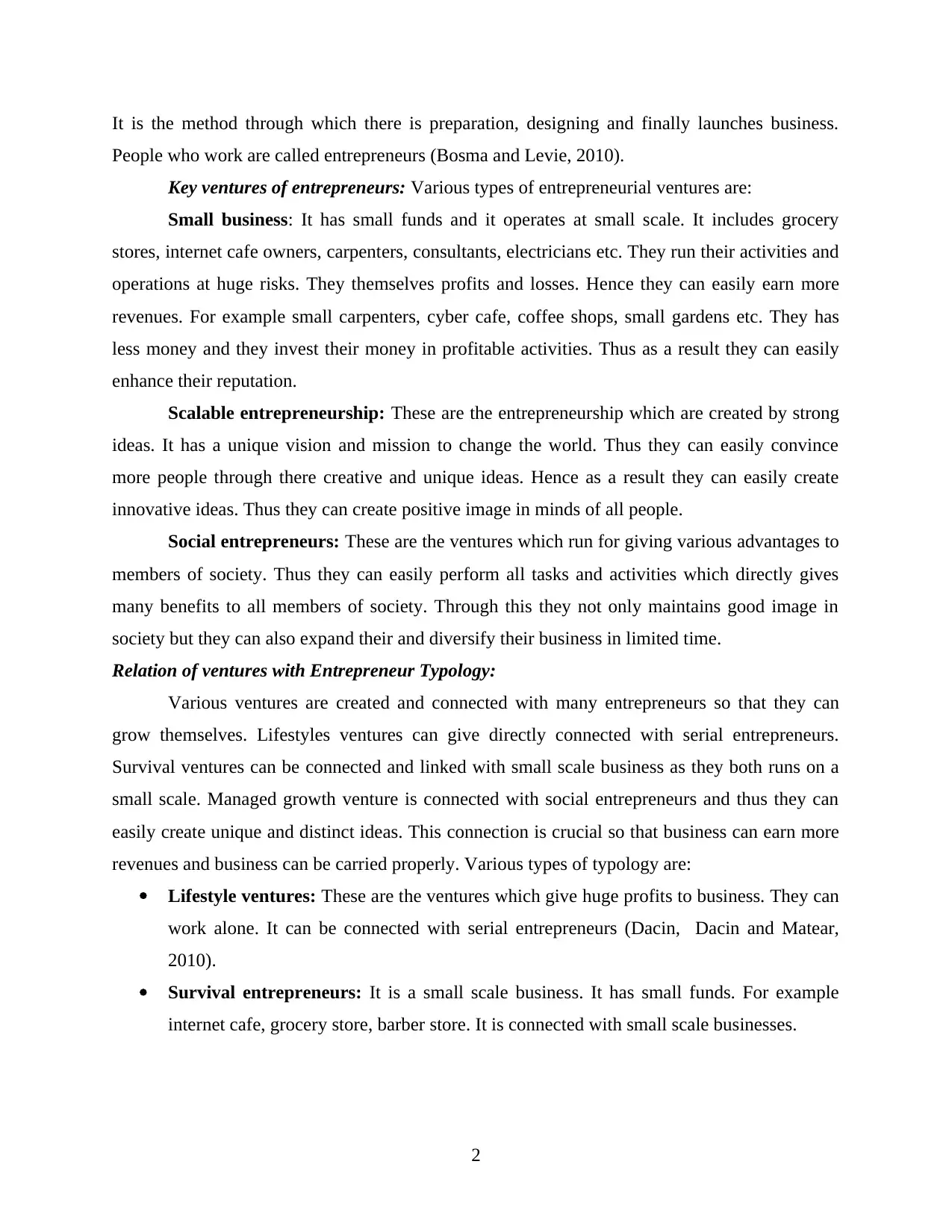
It is the method through which there is preparation, designing and finally launches business.
People who work are called entrepreneurs (Bosma and Levie, 2010).
Key ventures of entrepreneurs: Various types of entrepreneurial ventures are:
Small business: It has small funds and it operates at small scale. It includes grocery
stores, internet cafe owners, carpenters, consultants, electricians etc. They run their activities and
operations at huge risks. They themselves profits and losses. Hence they can easily earn more
revenues. For example small carpenters, cyber cafe, coffee shops, small gardens etc. They has
less money and they invest their money in profitable activities. Thus as a result they can easily
enhance their reputation.
Scalable entrepreneurship: These are the entrepreneurship which are created by strong
ideas. It has a unique vision and mission to change the world. Thus they can easily convince
more people through there creative and unique ideas. Hence as a result they can easily create
innovative ideas. Thus they can create positive image in minds of all people.
Social entrepreneurs: These are the ventures which run for giving various advantages to
members of society. Thus they can easily perform all tasks and activities which directly gives
many benefits to all members of society. Through this they not only maintains good image in
society but they can also expand their and diversify their business in limited time.
Relation of ventures with Entrepreneur Typology:
Various ventures are created and connected with many entrepreneurs so that they can
grow themselves. Lifestyles ventures can give directly connected with serial entrepreneurs.
Survival ventures can be connected and linked with small scale business as they both runs on a
small scale. Managed growth venture is connected with social entrepreneurs and thus they can
easily create unique and distinct ideas. This connection is crucial so that business can earn more
revenues and business can be carried properly. Various types of typology are:
Lifestyle ventures: These are the ventures which give huge profits to business. They can
work alone. It can be connected with serial entrepreneurs (Dacin, Dacin and Matear,
2010).
Survival entrepreneurs: It is a small scale business. It has small funds. For example
internet cafe, grocery store, barber store. It is connected with small scale businesses.
2
People who work are called entrepreneurs (Bosma and Levie, 2010).
Key ventures of entrepreneurs: Various types of entrepreneurial ventures are:
Small business: It has small funds and it operates at small scale. It includes grocery
stores, internet cafe owners, carpenters, consultants, electricians etc. They run their activities and
operations at huge risks. They themselves profits and losses. Hence they can easily earn more
revenues. For example small carpenters, cyber cafe, coffee shops, small gardens etc. They has
less money and they invest their money in profitable activities. Thus as a result they can easily
enhance their reputation.
Scalable entrepreneurship: These are the entrepreneurship which are created by strong
ideas. It has a unique vision and mission to change the world. Thus they can easily convince
more people through there creative and unique ideas. Hence as a result they can easily create
innovative ideas. Thus they can create positive image in minds of all people.
Social entrepreneurs: These are the ventures which run for giving various advantages to
members of society. Thus they can easily perform all tasks and activities which directly gives
many benefits to all members of society. Through this they not only maintains good image in
society but they can also expand their and diversify their business in limited time.
Relation of ventures with Entrepreneur Typology:
Various ventures are created and connected with many entrepreneurs so that they can
grow themselves. Lifestyles ventures can give directly connected with serial entrepreneurs.
Survival ventures can be connected and linked with small scale business as they both runs on a
small scale. Managed growth venture is connected with social entrepreneurs and thus they can
easily create unique and distinct ideas. This connection is crucial so that business can earn more
revenues and business can be carried properly. Various types of typology are:
Lifestyle ventures: These are the ventures which give huge profits to business. They can
work alone. It can be connected with serial entrepreneurs (Dacin, Dacin and Matear,
2010).
Survival entrepreneurs: It is a small scale business. It has small funds. For example
internet cafe, grocery store, barber store. It is connected with small scale businesses.
2
Paraphrase This Document
Need a fresh take? Get an instant paraphrase of this document with our AI Paraphraser
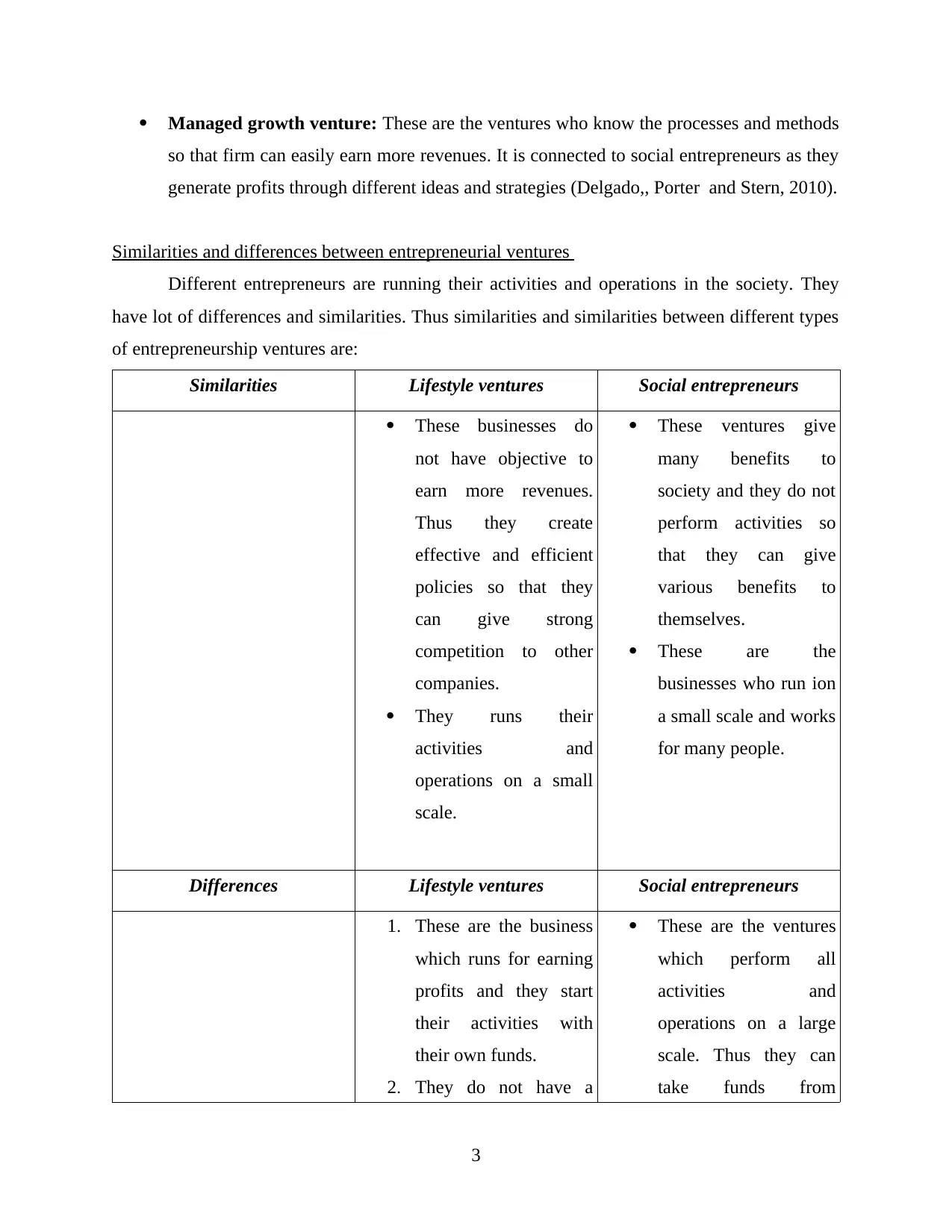
Managed growth venture: These are the ventures who know the processes and methods
so that firm can easily earn more revenues. It is connected to social entrepreneurs as they
generate profits through different ideas and strategies (Delgado,, Porter and Stern, 2010).
Similarities and differences between entrepreneurial ventures
Different entrepreneurs are running their activities and operations in the society. They
have lot of differences and similarities. Thus similarities and similarities between different types
of entrepreneurship ventures are:
Similarities Lifestyle ventures Social entrepreneurs
These businesses do
not have objective to
earn more revenues.
Thus they create
effective and efficient
policies so that they
can give strong
competition to other
companies.
They runs their
activities and
operations on a small
scale.
These ventures give
many benefits to
society and they do not
perform activities so
that they can give
various benefits to
themselves.
These are the
businesses who run ion
a small scale and works
for many people.
Differences Lifestyle ventures Social entrepreneurs
1. These are the business
which runs for earning
profits and they start
their activities with
their own funds.
2. They do not have a
These are the ventures
which perform all
activities and
operations on a large
scale. Thus they can
take funds from
3
so that firm can easily earn more revenues. It is connected to social entrepreneurs as they
generate profits through different ideas and strategies (Delgado,, Porter and Stern, 2010).
Similarities and differences between entrepreneurial ventures
Different entrepreneurs are running their activities and operations in the society. They
have lot of differences and similarities. Thus similarities and similarities between different types
of entrepreneurship ventures are:
Similarities Lifestyle ventures Social entrepreneurs
These businesses do
not have objective to
earn more revenues.
Thus they create
effective and efficient
policies so that they
can give strong
competition to other
companies.
They runs their
activities and
operations on a small
scale.
These ventures give
many benefits to
society and they do not
perform activities so
that they can give
various benefits to
themselves.
These are the
businesses who run ion
a small scale and works
for many people.
Differences Lifestyle ventures Social entrepreneurs
1. These are the business
which runs for earning
profits and they start
their activities with
their own funds.
2. They do not have a
These are the ventures
which perform all
activities and
operations on a large
scale. Thus they can
take funds from
3
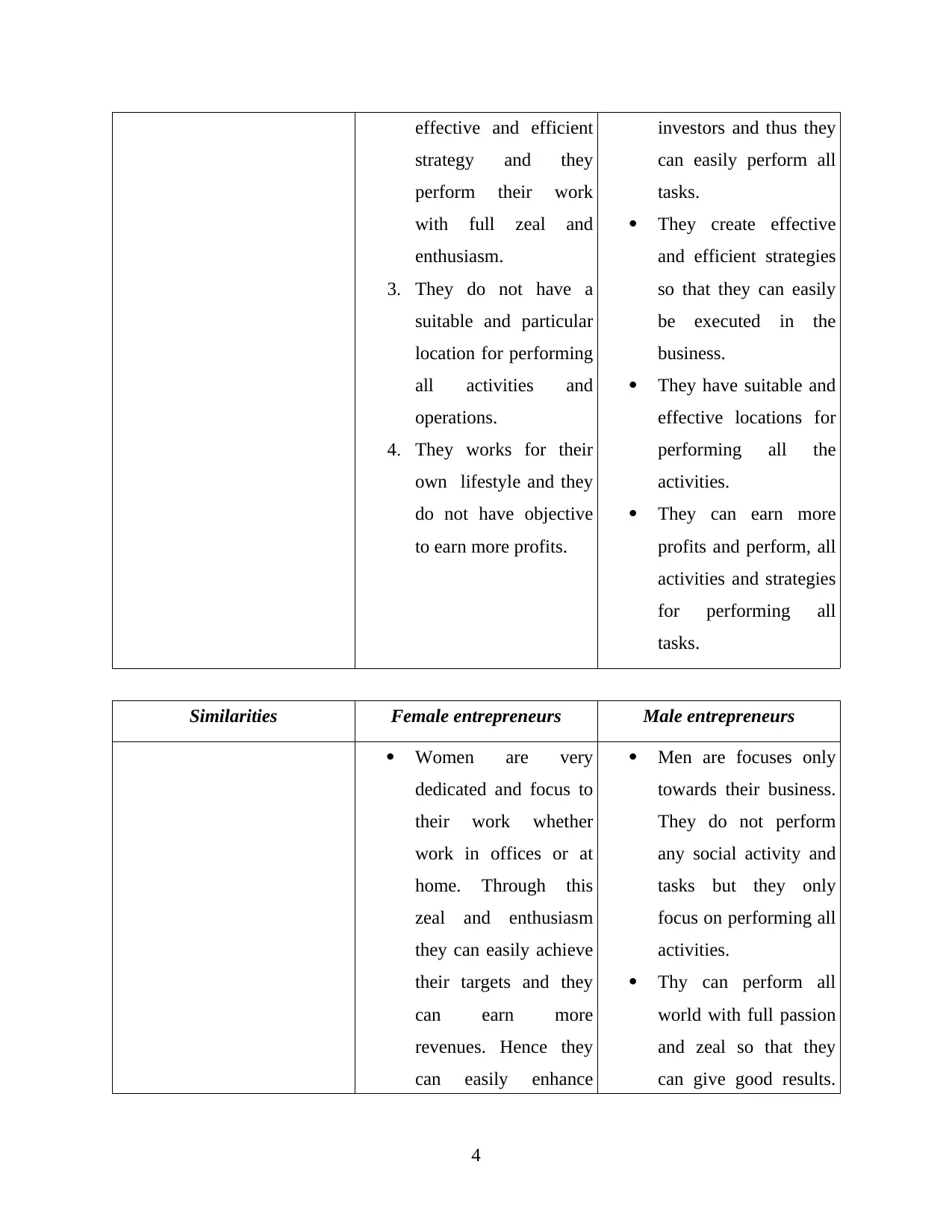
effective and efficient
strategy and they
perform their work
with full zeal and
enthusiasm.
3. They do not have a
suitable and particular
location for performing
all activities and
operations.
4. They works for their
own lifestyle and they
do not have objective
to earn more profits.
investors and thus they
can easily perform all
tasks.
They create effective
and efficient strategies
so that they can easily
be executed in the
business.
They have suitable and
effective locations for
performing all the
activities.
They can earn more
profits and perform, all
activities and strategies
for performing all
tasks.
Similarities Female entrepreneurs Male entrepreneurs
Women are very
dedicated and focus to
their work whether
work in offices or at
home. Through this
zeal and enthusiasm
they can easily achieve
their targets and they
can earn more
revenues. Hence they
can easily enhance
Men are focuses only
towards their business.
They do not perform
any social activity and
tasks but they only
focus on performing all
activities.
Thy can perform all
world with full passion
and zeal so that they
can give good results.
4
strategy and they
perform their work
with full zeal and
enthusiasm.
3. They do not have a
suitable and particular
location for performing
all activities and
operations.
4. They works for their
own lifestyle and they
do not have objective
to earn more profits.
investors and thus they
can easily perform all
tasks.
They create effective
and efficient strategies
so that they can easily
be executed in the
business.
They have suitable and
effective locations for
performing all the
activities.
They can earn more
profits and perform, all
activities and strategies
for performing all
tasks.
Similarities Female entrepreneurs Male entrepreneurs
Women are very
dedicated and focus to
their work whether
work in offices or at
home. Through this
zeal and enthusiasm
they can easily achieve
their targets and they
can earn more
revenues. Hence they
can easily enhance
Men are focuses only
towards their business.
They do not perform
any social activity and
tasks but they only
focus on performing all
activities.
Thy can perform all
world with full passion
and zeal so that they
can give good results.
4
⊘ This is a preview!⊘
Do you want full access?
Subscribe today to unlock all pages.

Trusted by 1+ million students worldwide
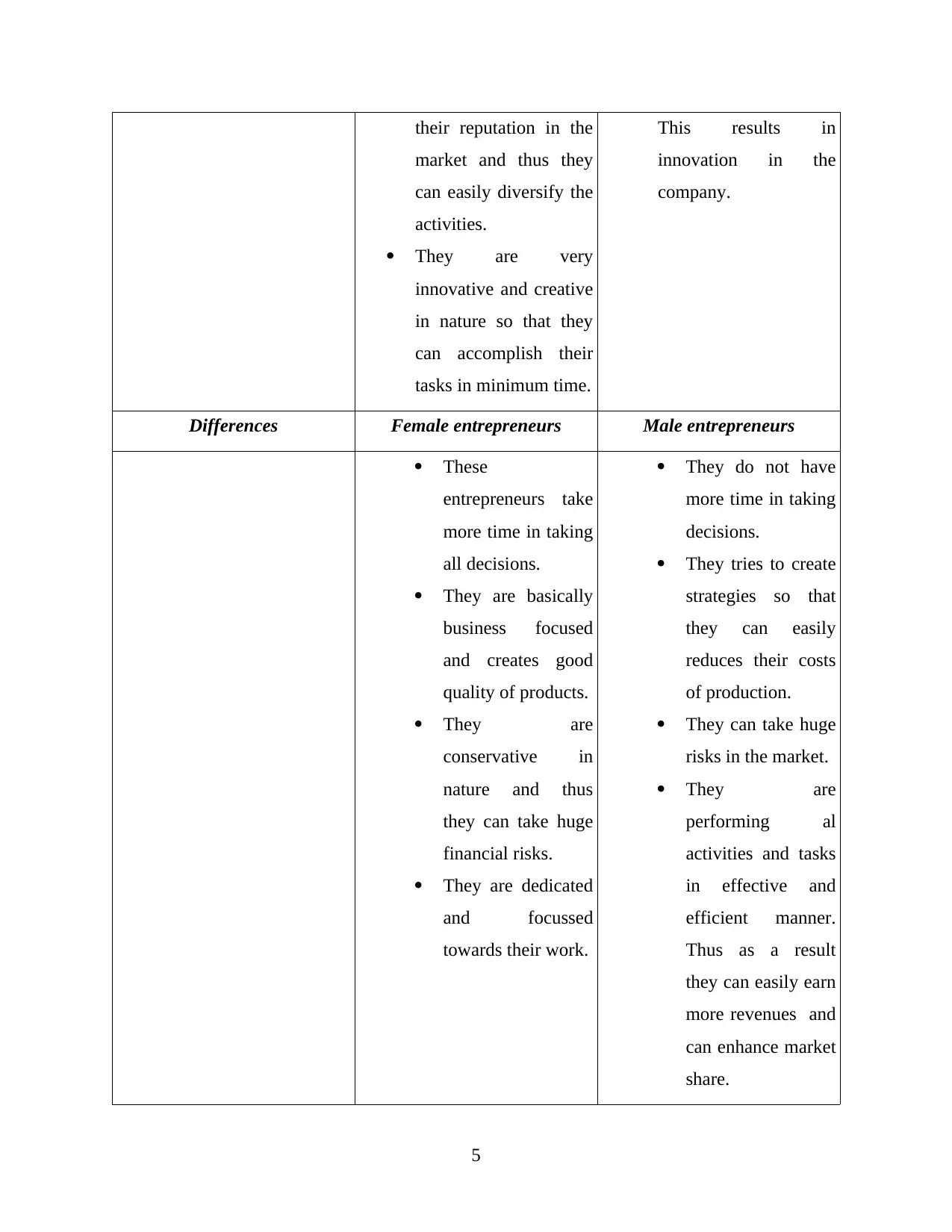
their reputation in the
market and thus they
can easily diversify the
activities.
They are very
innovative and creative
in nature so that they
can accomplish their
tasks in minimum time.
This results in
innovation in the
company.
Differences Female entrepreneurs Male entrepreneurs
These
entrepreneurs take
more time in taking
all decisions.
They are basically
business focused
and creates good
quality of products.
They are
conservative in
nature and thus
they can take huge
financial risks.
They are dedicated
and focussed
towards their work.
They do not have
more time in taking
decisions.
They tries to create
strategies so that
they can easily
reduces their costs
of production.
They can take huge
risks in the market.
They are
performing al
activities and tasks
in effective and
efficient manner.
Thus as a result
they can easily earn
more revenues and
can enhance market
share.
5
market and thus they
can easily diversify the
activities.
They are very
innovative and creative
in nature so that they
can accomplish their
tasks in minimum time.
This results in
innovation in the
company.
Differences Female entrepreneurs Male entrepreneurs
These
entrepreneurs take
more time in taking
all decisions.
They are basically
business focused
and creates good
quality of products.
They are
conservative in
nature and thus
they can take huge
financial risks.
They are dedicated
and focussed
towards their work.
They do not have
more time in taking
decisions.
They tries to create
strategies so that
they can easily
reduces their costs
of production.
They can take huge
risks in the market.
They are
performing al
activities and tasks
in effective and
efficient manner.
Thus as a result
they can easily earn
more revenues and
can enhance market
share.
5
Paraphrase This Document
Need a fresh take? Get an instant paraphrase of this document with our AI Paraphraser
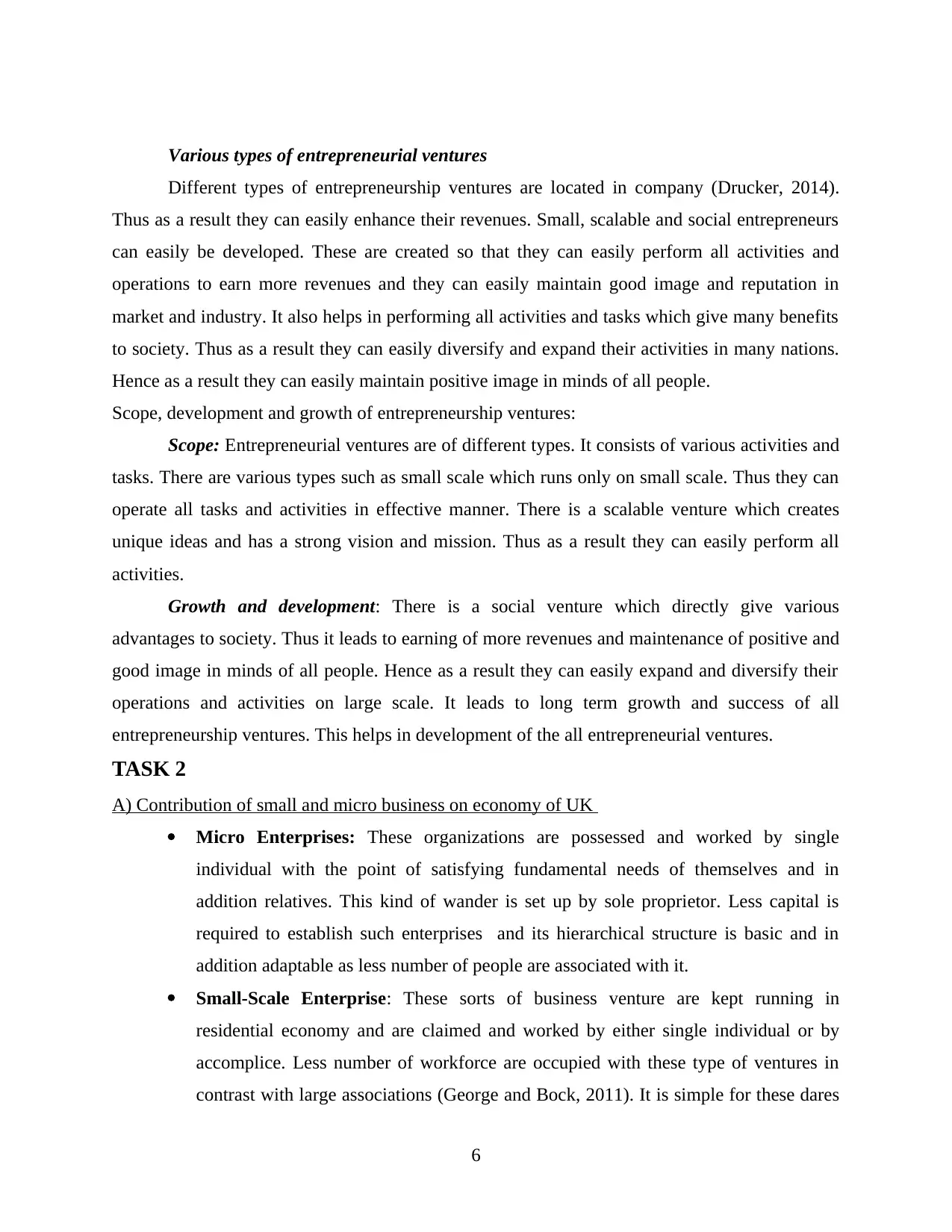
Various types of entrepreneurial ventures
Different types of entrepreneurship ventures are located in company (Drucker, 2014).
Thus as a result they can easily enhance their revenues. Small, scalable and social entrepreneurs
can easily be developed. These are created so that they can easily perform all activities and
operations to earn more revenues and they can easily maintain good image and reputation in
market and industry. It also helps in performing all activities and tasks which give many benefits
to society. Thus as a result they can easily diversify and expand their activities in many nations.
Hence as a result they can easily maintain positive image in minds of all people.
Scope, development and growth of entrepreneurship ventures:
Scope: Entrepreneurial ventures are of different types. It consists of various activities and
tasks. There are various types such as small scale which runs only on small scale. Thus they can
operate all tasks and activities in effective manner. There is a scalable venture which creates
unique ideas and has a strong vision and mission. Thus as a result they can easily perform all
activities.
Growth and development: There is a social venture which directly give various
advantages to society. Thus it leads to earning of more revenues and maintenance of positive and
good image in minds of all people. Hence as a result they can easily expand and diversify their
operations and activities on large scale. It leads to long term growth and success of all
entrepreneurship ventures. This helps in development of the all entrepreneurial ventures.
TASK 2
A) Contribution of small and micro business on economy of UK
Micro Enterprises: These organizations are possessed and worked by single
individual with the point of satisfying fundamental needs of themselves and in
addition relatives. This kind of wander is set up by sole proprietor. Less capital is
required to establish such enterprises and its hierarchical structure is basic and in
addition adaptable as less number of people are associated with it.
Small-Scale Enterprise: These sorts of business venture are kept running in
residential economy and are claimed and worked by either single individual or by
accomplice. Less number of workforce are occupied with these type of ventures in
contrast with large associations (George and Bock, 2011). It is simple for these dares
6
Different types of entrepreneurship ventures are located in company (Drucker, 2014).
Thus as a result they can easily enhance their revenues. Small, scalable and social entrepreneurs
can easily be developed. These are created so that they can easily perform all activities and
operations to earn more revenues and they can easily maintain good image and reputation in
market and industry. It also helps in performing all activities and tasks which give many benefits
to society. Thus as a result they can easily diversify and expand their activities in many nations.
Hence as a result they can easily maintain positive image in minds of all people.
Scope, development and growth of entrepreneurship ventures:
Scope: Entrepreneurial ventures are of different types. It consists of various activities and
tasks. There are various types such as small scale which runs only on small scale. Thus they can
operate all tasks and activities in effective manner. There is a scalable venture which creates
unique ideas and has a strong vision and mission. Thus as a result they can easily perform all
activities.
Growth and development: There is a social venture which directly give various
advantages to society. Thus it leads to earning of more revenues and maintenance of positive and
good image in minds of all people. Hence as a result they can easily expand and diversify their
operations and activities on large scale. It leads to long term growth and success of all
entrepreneurship ventures. This helps in development of the all entrepreneurial ventures.
TASK 2
A) Contribution of small and micro business on economy of UK
Micro Enterprises: These organizations are possessed and worked by single
individual with the point of satisfying fundamental needs of themselves and in
addition relatives. This kind of wander is set up by sole proprietor. Less capital is
required to establish such enterprises and its hierarchical structure is basic and in
addition adaptable as less number of people are associated with it.
Small-Scale Enterprise: These sorts of business venture are kept running in
residential economy and are claimed and worked by either single individual or by
accomplice. Less number of workforce are occupied with these type of ventures in
contrast with large associations (George and Bock, 2011). It is simple for these dares
6
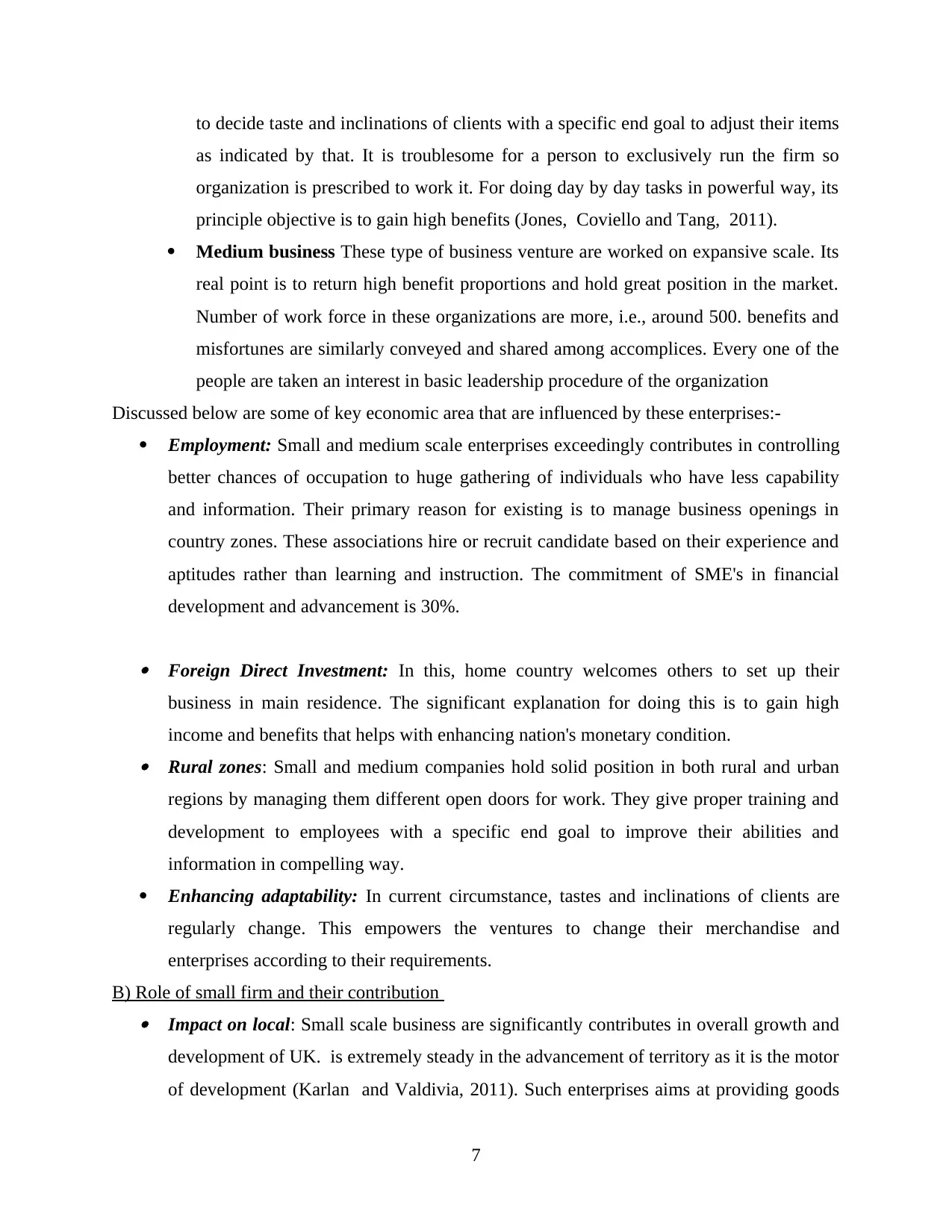
to decide taste and inclinations of clients with a specific end goal to adjust their items
as indicated by that. It is troublesome for a person to exclusively run the firm so
organization is prescribed to work it. For doing day by day tasks in powerful way, its
principle objective is to gain high benefits (Jones, Coviello and Tang, 2011).
Medium business These type of business venture are worked on expansive scale. Its
real point is to return high benefit proportions and hold great position in the market.
Number of work force in these organizations are more, i.e., around 500. benefits and
misfortunes are similarly conveyed and shared among accomplices. Every one of the
people are taken an interest in basic leadership procedure of the organization
Discussed below are some of key economic area that are influenced by these enterprises:-
Employment: Small and medium scale enterprises exceedingly contributes in controlling
better chances of occupation to huge gathering of individuals who have less capability
and information. Their primary reason for existing is to manage business openings in
country zones. These associations hire or recruit candidate based on their experience and
aptitudes rather than learning and instruction. The commitment of SME's in financial
development and advancement is 30%.
Foreign Direct Investment: In this, home country welcomes others to set up their
business in main residence. The significant explanation for doing this is to gain high
income and benefits that helps with enhancing nation's monetary condition. Rural zones: Small and medium companies hold solid position in both rural and urban
regions by managing them different open doors for work. They give proper training and
development to employees with a specific end goal to improve their abilities and
information in compelling way.
Enhancing adaptability: In current circumstance, tastes and inclinations of clients are
regularly change. This empowers the ventures to change their merchandise and
enterprises according to their requirements.
B) Role of small firm and their contribution Impact on local: Small scale business are significantly contributes in overall growth and
development of UK. is extremely steady in the advancement of territory as it is the motor
of development (Karlan and Valdivia, 2011). Such enterprises aims at providing goods
7
as indicated by that. It is troublesome for a person to exclusively run the firm so
organization is prescribed to work it. For doing day by day tasks in powerful way, its
principle objective is to gain high benefits (Jones, Coviello and Tang, 2011).
Medium business These type of business venture are worked on expansive scale. Its
real point is to return high benefit proportions and hold great position in the market.
Number of work force in these organizations are more, i.e., around 500. benefits and
misfortunes are similarly conveyed and shared among accomplices. Every one of the
people are taken an interest in basic leadership procedure of the organization
Discussed below are some of key economic area that are influenced by these enterprises:-
Employment: Small and medium scale enterprises exceedingly contributes in controlling
better chances of occupation to huge gathering of individuals who have less capability
and information. Their primary reason for existing is to manage business openings in
country zones. These associations hire or recruit candidate based on their experience and
aptitudes rather than learning and instruction. The commitment of SME's in financial
development and advancement is 30%.
Foreign Direct Investment: In this, home country welcomes others to set up their
business in main residence. The significant explanation for doing this is to gain high
income and benefits that helps with enhancing nation's monetary condition. Rural zones: Small and medium companies hold solid position in both rural and urban
regions by managing them different open doors for work. They give proper training and
development to employees with a specific end goal to improve their abilities and
information in compelling way.
Enhancing adaptability: In current circumstance, tastes and inclinations of clients are
regularly change. This empowers the ventures to change their merchandise and
enterprises according to their requirements.
B) Role of small firm and their contribution Impact on local: Small scale business are significantly contributes in overall growth and
development of UK. is extremely steady in the advancement of territory as it is the motor
of development (Karlan and Valdivia, 2011). Such enterprises aims at providing goods
7
⊘ This is a preview!⊘
Do you want full access?
Subscribe today to unlock all pages.

Trusted by 1+ million students worldwide
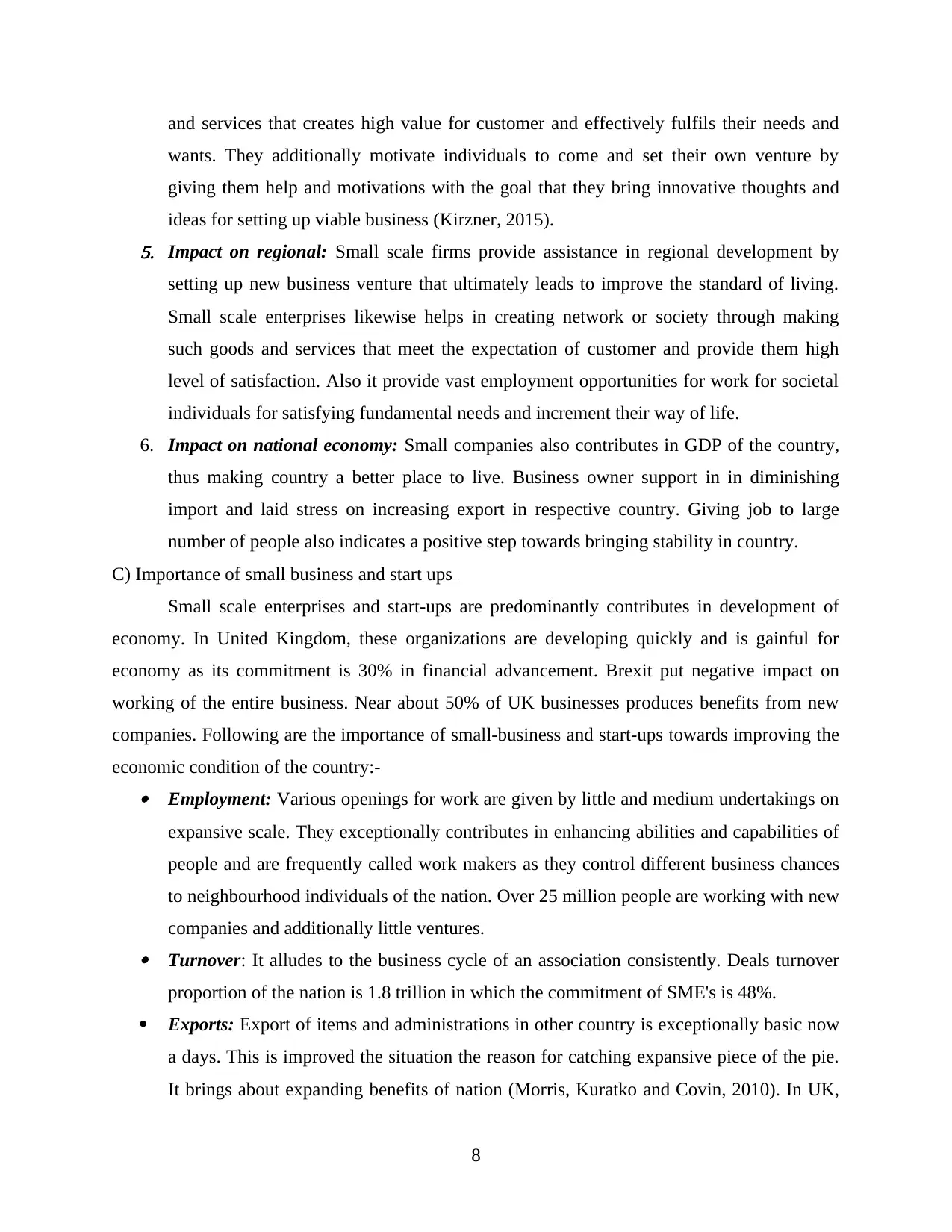
and services that creates high value for customer and effectively fulfils their needs and
wants. They additionally motivate individuals to come and set their own venture by
giving them help and motivations with the goal that they bring innovative thoughts and
ideas for setting up viable business (Kirzner, 2015).5. Impact on regional: Small scale firms provide assistance in regional development by
setting up new business venture that ultimately leads to improve the standard of living.
Small scale enterprises likewise helps in creating network or society through making
such goods and services that meet the expectation of customer and provide them high
level of satisfaction. Also it provide vast employment opportunities for work for societal
individuals for satisfying fundamental needs and increment their way of life.
6. Impact on national economy: Small companies also contributes in GDP of the country,
thus making country a better place to live. Business owner support in in diminishing
import and laid stress on increasing export in respective country. Giving job to large
number of people also indicates a positive step towards bringing stability in country.
C) Importance of small business and start ups
Small scale enterprises and start-ups are predominantly contributes in development of
economy. In United Kingdom, these organizations are developing quickly and is gainful for
economy as its commitment is 30% in financial advancement. Brexit put negative impact on
working of the entire business. Near about 50% of UK businesses produces benefits from new
companies. Following are the importance of small-business and start-ups towards improving the
economic condition of the country:- Employment: Various openings for work are given by little and medium undertakings on
expansive scale. They exceptionally contributes in enhancing abilities and capabilities of
people and are frequently called work makers as they control different business chances
to neighbourhood individuals of the nation. Over 25 million people are working with new
companies and additionally little ventures. Turnover: It alludes to the business cycle of an association consistently. Deals turnover
proportion of the nation is 1.8 trillion in which the commitment of SME's is 48%.
Exports: Export of items and administrations in other country is exceptionally basic now
a days. This is improved the situation the reason for catching expansive piece of the pie.
It brings about expanding benefits of nation (Morris, Kuratko and Covin, 2010). In UK,
8
wants. They additionally motivate individuals to come and set their own venture by
giving them help and motivations with the goal that they bring innovative thoughts and
ideas for setting up viable business (Kirzner, 2015).5. Impact on regional: Small scale firms provide assistance in regional development by
setting up new business venture that ultimately leads to improve the standard of living.
Small scale enterprises likewise helps in creating network or society through making
such goods and services that meet the expectation of customer and provide them high
level of satisfaction. Also it provide vast employment opportunities for work for societal
individuals for satisfying fundamental needs and increment their way of life.
6. Impact on national economy: Small companies also contributes in GDP of the country,
thus making country a better place to live. Business owner support in in diminishing
import and laid stress on increasing export in respective country. Giving job to large
number of people also indicates a positive step towards bringing stability in country.
C) Importance of small business and start ups
Small scale enterprises and start-ups are predominantly contributes in development of
economy. In United Kingdom, these organizations are developing quickly and is gainful for
economy as its commitment is 30% in financial advancement. Brexit put negative impact on
working of the entire business. Near about 50% of UK businesses produces benefits from new
companies. Following are the importance of small-business and start-ups towards improving the
economic condition of the country:- Employment: Various openings for work are given by little and medium undertakings on
expansive scale. They exceptionally contributes in enhancing abilities and capabilities of
people and are frequently called work makers as they control different business chances
to neighbourhood individuals of the nation. Over 25 million people are working with new
companies and additionally little ventures. Turnover: It alludes to the business cycle of an association consistently. Deals turnover
proportion of the nation is 1.8 trillion in which the commitment of SME's is 48%.
Exports: Export of items and administrations in other country is exceptionally basic now
a days. This is improved the situation the reason for catching expansive piece of the pie.
It brings about expanding benefits of nation (Morris, Kuratko and Covin, 2010). In UK,
8
Paraphrase This Document
Need a fresh take? Get an instant paraphrase of this document with our AI Paraphraser
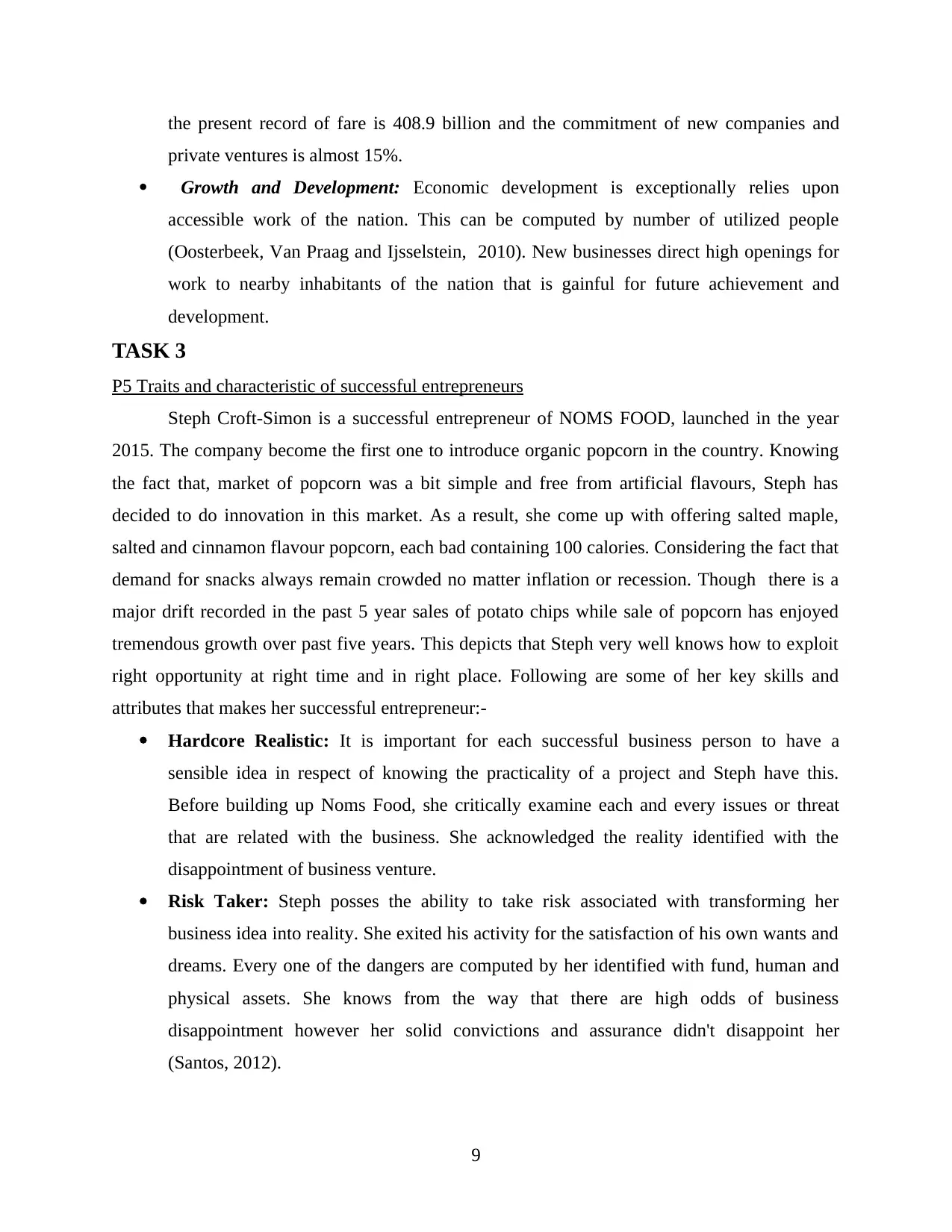
the present record of fare is 408.9 billion and the commitment of new companies and
private ventures is almost 15%.
Growth and Development: Economic development is exceptionally relies upon
accessible work of the nation. This can be computed by number of utilized people
(Oosterbeek, Van Praag and Ijsselstein, 2010). New businesses direct high openings for
work to nearby inhabitants of the nation that is gainful for future achievement and
development.
TASK 3
P5 Traits and characteristic of successful entrepreneurs
Steph Croft-Simon is a successful entrepreneur of NOMS FOOD, launched in the year
2015. The company become the first one to introduce organic popcorn in the country. Knowing
the fact that, market of popcorn was a bit simple and free from artificial flavours, Steph has
decided to do innovation in this market. As a result, she come up with offering salted maple,
salted and cinnamon flavour popcorn, each bad containing 100 calories. Considering the fact that
demand for snacks always remain crowded no matter inflation or recession. Though there is a
major drift recorded in the past 5 year sales of potato chips while sale of popcorn has enjoyed
tremendous growth over past five years. This depicts that Steph very well knows how to exploit
right opportunity at right time and in right place. Following are some of her key skills and
attributes that makes her successful entrepreneur:-
Hardcore Realistic: It is important for each successful business person to have a
sensible idea in respect of knowing the practicality of a project and Steph have this.
Before building up Noms Food, she critically examine each and every issues or threat
that are related with the business. She acknowledged the reality identified with the
disappointment of business venture.
Risk Taker: Steph posses the ability to take risk associated with transforming her
business idea into reality. She exited his activity for the satisfaction of his own wants and
dreams. Every one of the dangers are computed by her identified with fund, human and
physical assets. She knows from the way that there are high odds of business
disappointment however her solid convictions and assurance didn't disappoint her
(Santos, 2012).
9
private ventures is almost 15%.
Growth and Development: Economic development is exceptionally relies upon
accessible work of the nation. This can be computed by number of utilized people
(Oosterbeek, Van Praag and Ijsselstein, 2010). New businesses direct high openings for
work to nearby inhabitants of the nation that is gainful for future achievement and
development.
TASK 3
P5 Traits and characteristic of successful entrepreneurs
Steph Croft-Simon is a successful entrepreneur of NOMS FOOD, launched in the year
2015. The company become the first one to introduce organic popcorn in the country. Knowing
the fact that, market of popcorn was a bit simple and free from artificial flavours, Steph has
decided to do innovation in this market. As a result, she come up with offering salted maple,
salted and cinnamon flavour popcorn, each bad containing 100 calories. Considering the fact that
demand for snacks always remain crowded no matter inflation or recession. Though there is a
major drift recorded in the past 5 year sales of potato chips while sale of popcorn has enjoyed
tremendous growth over past five years. This depicts that Steph very well knows how to exploit
right opportunity at right time and in right place. Following are some of her key skills and
attributes that makes her successful entrepreneur:-
Hardcore Realistic: It is important for each successful business person to have a
sensible idea in respect of knowing the practicality of a project and Steph have this.
Before building up Noms Food, she critically examine each and every issues or threat
that are related with the business. She acknowledged the reality identified with the
disappointment of business venture.
Risk Taker: Steph posses the ability to take risk associated with transforming her
business idea into reality. She exited his activity for the satisfaction of his own wants and
dreams. Every one of the dangers are computed by her identified with fund, human and
physical assets. She knows from the way that there are high odds of business
disappointment however her solid convictions and assurance didn't disappoint her
(Santos, 2012).
9
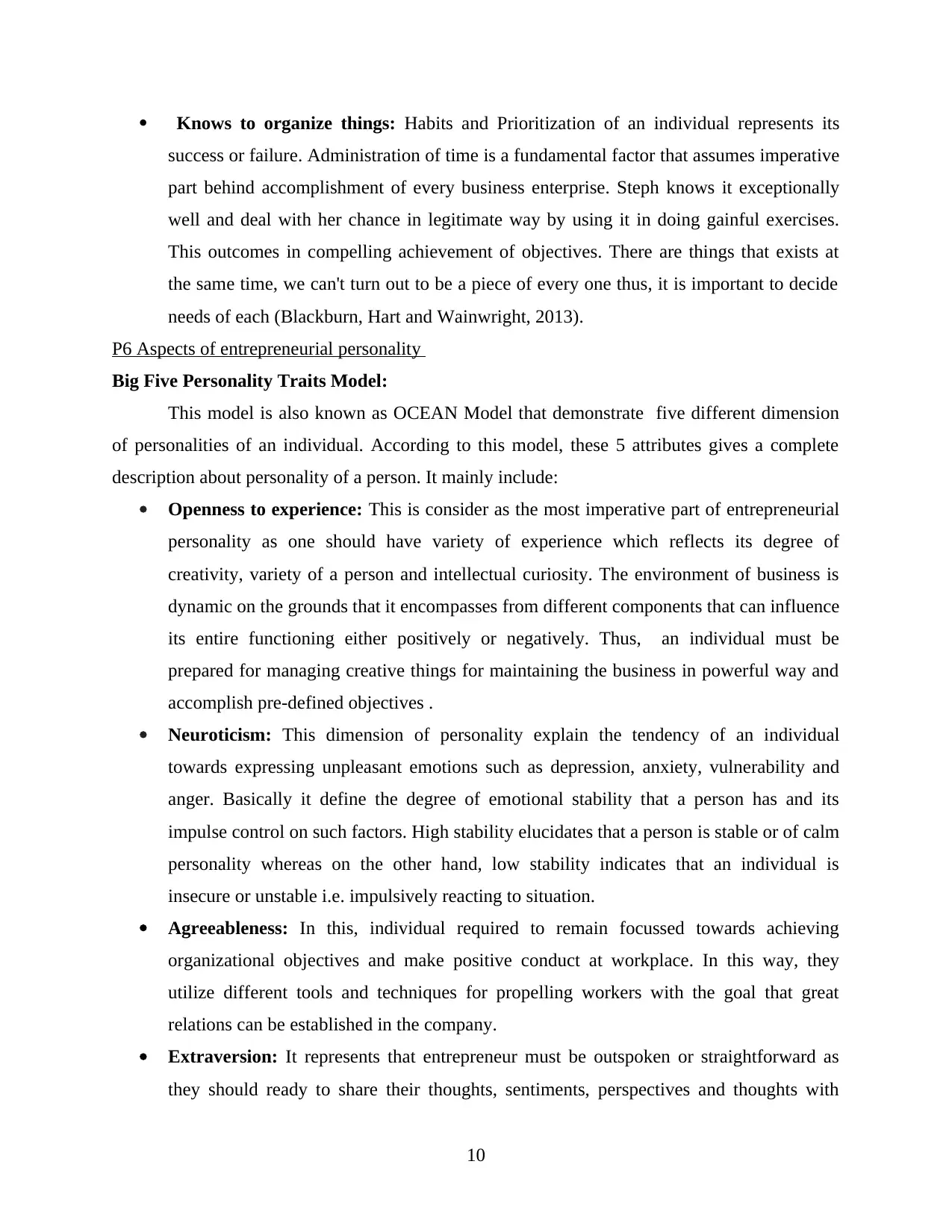
Knows to organize things: Habits and Prioritization of an individual represents its
success or failure. Administration of time is a fundamental factor that assumes imperative
part behind accomplishment of every business enterprise. Steph knows it exceptionally
well and deal with her chance in legitimate way by using it in doing gainful exercises.
This outcomes in compelling achievement of objectives. There are things that exists at
the same time, we can't turn out to be a piece of every one thus, it is important to decide
needs of each (Blackburn, Hart and Wainwright, 2013).
P6 Aspects of entrepreneurial personality
Big Five Personality Traits Model:
This model is also known as OCEAN Model that demonstrate five different dimension
of personalities of an individual. According to this model, these 5 attributes gives a complete
description about personality of a person. It mainly include:
Openness to experience: This is consider as the most imperative part of entrepreneurial
personality as one should have variety of experience which reflects its degree of
creativity, variety of a person and intellectual curiosity. The environment of business is
dynamic on the grounds that it encompasses from different components that can influence
its entire functioning either positively or negatively. Thus, an individual must be
prepared for managing creative things for maintaining the business in powerful way and
accomplish pre-defined objectives .
Neuroticism: This dimension of personality explain the tendency of an individual
towards expressing unpleasant emotions such as depression, anxiety, vulnerability and
anger. Basically it define the degree of emotional stability that a person has and its
impulse control on such factors. High stability elucidates that a person is stable or of calm
personality whereas on the other hand, low stability indicates that an individual is
insecure or unstable i.e. impulsively reacting to situation.
Agreeableness: In this, individual required to remain focussed towards achieving
organizational objectives and make positive conduct at workplace. In this way, they
utilize different tools and techniques for propelling workers with the goal that great
relations can be established in the company.
Extraversion: It represents that entrepreneur must be outspoken or straightforward as
they should ready to share their thoughts, sentiments, perspectives and thoughts with
10
success or failure. Administration of time is a fundamental factor that assumes imperative
part behind accomplishment of every business enterprise. Steph knows it exceptionally
well and deal with her chance in legitimate way by using it in doing gainful exercises.
This outcomes in compelling achievement of objectives. There are things that exists at
the same time, we can't turn out to be a piece of every one thus, it is important to decide
needs of each (Blackburn, Hart and Wainwright, 2013).
P6 Aspects of entrepreneurial personality
Big Five Personality Traits Model:
This model is also known as OCEAN Model that demonstrate five different dimension
of personalities of an individual. According to this model, these 5 attributes gives a complete
description about personality of a person. It mainly include:
Openness to experience: This is consider as the most imperative part of entrepreneurial
personality as one should have variety of experience which reflects its degree of
creativity, variety of a person and intellectual curiosity. The environment of business is
dynamic on the grounds that it encompasses from different components that can influence
its entire functioning either positively or negatively. Thus, an individual must be
prepared for managing creative things for maintaining the business in powerful way and
accomplish pre-defined objectives .
Neuroticism: This dimension of personality explain the tendency of an individual
towards expressing unpleasant emotions such as depression, anxiety, vulnerability and
anger. Basically it define the degree of emotional stability that a person has and its
impulse control on such factors. High stability elucidates that a person is stable or of calm
personality whereas on the other hand, low stability indicates that an individual is
insecure or unstable i.e. impulsively reacting to situation.
Agreeableness: In this, individual required to remain focussed towards achieving
organizational objectives and make positive conduct at workplace. In this way, they
utilize different tools and techniques for propelling workers with the goal that great
relations can be established in the company.
Extraversion: It represents that entrepreneur must be outspoken or straightforward as
they should ready to share their thoughts, sentiments, perspectives and thoughts with
10
⊘ This is a preview!⊘
Do you want full access?
Subscribe today to unlock all pages.

Trusted by 1+ million students worldwide
1 out of 16
Related Documents
Your All-in-One AI-Powered Toolkit for Academic Success.
+13062052269
info@desklib.com
Available 24*7 on WhatsApp / Email
![[object Object]](/_next/static/media/star-bottom.7253800d.svg)
Unlock your academic potential
Copyright © 2020–2026 A2Z Services. All Rights Reserved. Developed and managed by ZUCOL.





